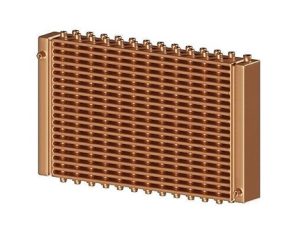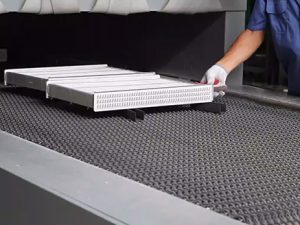Table of Contents
- The Early Days: Copper Radiators
- The Shift to Brass and Aluminum: Enhancing Performance and Reducing Weight
- The Rise of Plastic Tanks: A Game Changer in Design and Manufacturing
- The Future of Car Radiators: Advancements in Materials and Efficiency
- Materials Used in Car Radiators Over Time
Car radiators have evolved significantly ov
er the years, from simple cooling devices made of copper to the modern, highly engineered systems that utilize advanced materials like aluminum and plastic. This transformation is not only a testament to the technological advancements in automotive design but also highlights the changing needs for efficiency, durability, and cost-effectiveness. In this article, we will take a deep dive into the history and evolution of car radiators, exploring the materials and designs that have shaped the cooling systems we rely on today.
The Early Days: Copper Radiators

In the early days of automobile manufacturing, radiators were primarily made of copper. Copper was widely used because of its excellent thermal conductivity, which allowed it to dissipate heat effectively and efficiently. The radiator’s primary function was simple: to prevent the engine from overheating by regulating the temperature of the coolant that passed through it.
Key Features of Copper Radiators:
- Thermal Efficiency: Copper has a high thermal conductivity, meaning it can quickly transfer heat from the engine coolant to the air.
- Durability: Copper radiators were relatively durable, but over time, they were prone to corrosion, especially when exposed to moisture or acidic coolant.
- Weight: Copper radiators were relatively heavy, which added to the overall weight of the vehicle.
While copper radiators performed well, they had several limitations. They were heavy, expensive to produce, and susceptible to corrosion. As the automotive industry grew and technology advanced, the need for a more efficient and cost-effective material became apparent.
The Shift to Brass and Aluminum: Enhancing Performance and Reducing Weight
In the mid-20th century, as car manufacturing scaled up, automotive engineers began exploring alternative materials to improve radiator performance. Brass and aluminum quickly emerged as the two primary alternatives to copper.
Brass Radiators
Brass, an alloy of copper and zinc, was a popular choice for radiators in the mid-1900s. It was stronger and more resistant to corrosion than copper, making it a more durable option for radiators.
Key Features of Brass Radiators:
- Corrosion Resistance: Brass is more resistant to corrosion than pure copper, which increased the lifespan of radiators.
- Stronger Construction: Brass radiators were stronger and could withstand higher pressure.
- Weight: Brass was still relatively heavy, although slightly lighter than copper.
However, brass radiators were still heavier than what was desired, and they did not offer the same level of thermal efficiency as other materials.
Aluminum Radiators
Aluminum, with its lighter weight and good thermal conductivity, soon became the material of choice for car radiators. Aluminum radiators offered significant advantages over their copper and brass counterparts, especially in terms of weight reduction and efficiency.
Key Features of Aluminum Radiators:
- Lightweight: Aluminum is much lighter than brass and copper, which reduces the overall weight of the vehicle.
- Thermal Efficiency: Aluminum is a good conductor of heat, meaning it can efficiently dissipate heat from the engine coolant.
- Corrosion Resistance: Aluminum radiators are highly resistant to corrosion, especially when coated with anti-corrosion materials.
- Cost-Effective: Aluminum is less expensive to produce than brass and copper, making it a more cost-effective option for car manufacturers.
The switch to aluminum radiators marked a turning point in the automotive industry, as they were not only lighter and more durable but also offered better cooling efficiency. Aluminum’s ability to dissipate heat efficiently made it ideal for high-performance vehicles and engines that required constant temperature regulation.
The Rise of Plastic Tanks: A Game Changer in Design and Manufacturing
In recent decades, plastic has been introduced into radiator design, particularly in the form of plastic tanks attached to aluminum cores. This combination has allowed manufacturers to reduce the overall weight of radiators further while maintaining performance.
Plastic tanks are often used to house the coolant and provide structural integrity, while the aluminum core continues to perform the heat dissipation function.
Key Features of Plastic-Aluminum Radiators:
- Lightweight: The combination of plastic and aluminum is much lighter than older brass and copper designs.
- Cost-Effective: Plastic is a cheap material, which significantly reduces the overall manufacturing cost of the radiator.
- Durability: Modern plastic radiators are designed to withstand the high temperatures and pressures of modern engines, and the plastic tanks are reinforced with fiberglass to prevent damage.
- Improved Aerodynamics: Plastic radiators are often designed to be more streamlined, contributing to better overall vehicle aerodynamics.
Despite their advantages, plastic tanks can be vulnerable to cracking, especially when exposed to extreme temperatures or pressure. However, improvements in plastic formulations and manufacturing processes have made these radiators more reliable than ever before.
The Future of Car Radiators: Advancements in Materials and Efficiency

As the automotive industry continues to evolve, so too does radiator technology. The push toward electric vehicles (EVs) and hybrid vehicles has changed the way car radiators are designed and used. These vehicles generate less heat than traditional combustion engines, which has led to the development of smaller, more efficient cooling systems.
Furthermore, the use of composite materials is becoming more common in radiator manufacturing. These materials, which combine plastics, metals, and ceramics, can provide improved performance in terms of heat dissipation, weight, and cost. Additionally, advancements in 3D printing technology may allow for custom radiator designs that offer optimal efficiency for specific vehicle models.
Key Trends in the Future of Radiator Design:
- Smaller and More Efficient: As vehicles become more energy-efficient, radiators will need to be smaller, yet still capable of maintaining optimal engine temperatures.
- Hybrid Materials: Composite materials will likely play a larger role in radiator design, improving performance while reducing weight and cost.
- Integration with Cooling Systems: Future radiators may be integrated with other vehicle systems, such as air conditioning or even battery cooling systems, to improve overall energy efficiency.
Materials Used in Car Radiators Over Time
| Material | Advantages | Disadvantages |
|---|---|---|
| Copper | Excellent thermal conductivity, durable | Heavy, prone to corrosion |
| Brass | Corrosion-resistant, durable | Heavier than aluminum, lower heat dissipation |
| Aluminum | Lightweight, corrosion-resistant, cost-effective | Less durable than brass, can corrode if not treated |
| Plastic-Aluminum | Lightweight, cost-effective, durable | Plastic can crack under extreme conditions |
Conclusion
The evolution of car radiators has come a long way from the early days of copper to the modern, composite designs we see today. The move from copper to aluminum and the integration of plastic tanks has significantly improved radiator performance, reduced weight, and lowered costs. As the automotive industry continues to push for better efficiency, we can expect even more innovative radiator designs that will support the changing needs of modern vehicles.